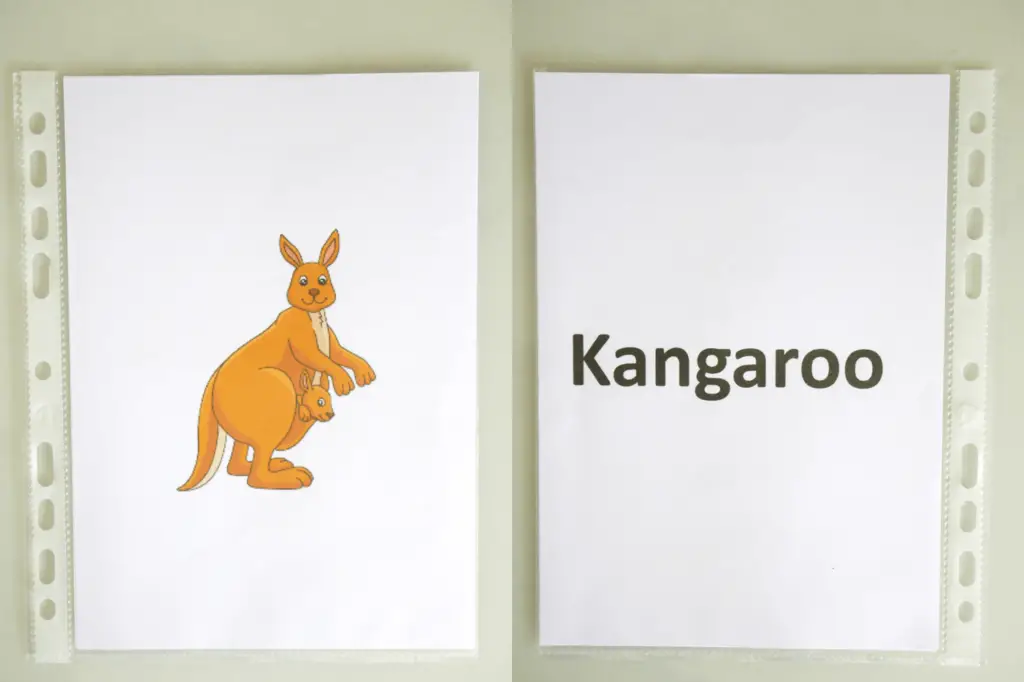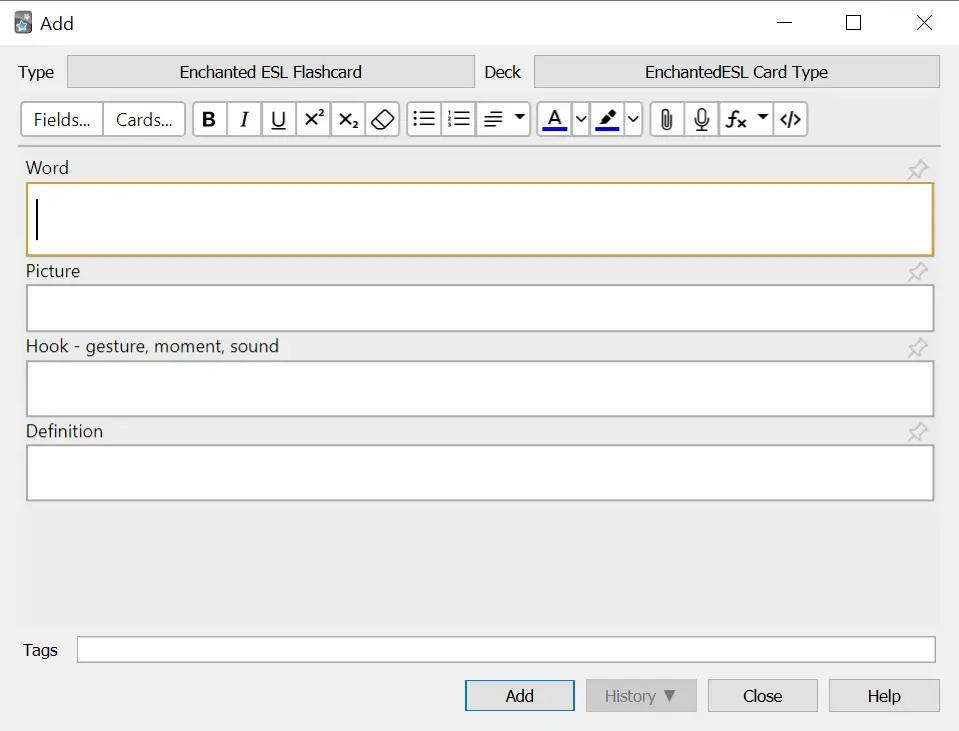Do you feel like your students always forget vocab you teach them? Have you found it difficult to get them engaged in learning new words?
This is a problem many EFL/ESL teachers have. We’re aware vocabulary is an important part of learning English, but traditional techniques just don’t seem to work. Students struggle to memorise words for a quiz, then forget them all straight after. It’s so frustrating!
Fortunately, you’re in the right place to make a change. In this extensive article, I’m going to change your perspective of teaching vocabulary and give you all the tools to turn your students from empty vessels into abundant users of all sorts of words.

So throw away your vocab tests and textbook word lists. We’re going to touch on some science with my model of the brain, give words value, apply some deep memorisation methods and use the powers of modern technology to ensure vocab learning lasts forever.
I’ve seen others on the internet using some of these techniques, but as far as I know, nobody has put them all together to create a complete method like this one.
So let’s learn the best way to teach EFL/ESL vocabulary!
Contents
Tell the brain to build mental connections (brain road analogy)
Acquisition
Provide context so students care (elicitation)
Take advantage of valuable moments (organic acquisition)
Memorisation
Activate the visual mind
Tap in to the locomotor system (with gestures)
Strengthen recall with sounds
Unleash the power of emotions
Retention
Use spaced-repetition for perfect timing
Use the Anki app
Use a scheduling system
Make practice varied and engaging
Create appropriate flashcards
Make it FUN (vocab games & gamification)
BONUS TIPS to excel at teaching vocab
Pronunciation
Synonyms & antonyms
Associated words and collocations
Word transformations
Translating from students’ first language
Notebooks or words on display
“Homework”
Start here
First of all, I’d like to point out that teaching vocabulary in EFL/ESL is a huge topic. It goes far beyond the reach of this single overview article, and it’s something that requires plenty of research and practice.
I have many posts that go into detail about particular aspects of how to teach vocabulary, and I’ve placed links to them wherever they might be useful.
So treat this article like a zoomed out guide, giving you the full picture of everything you need to know, without going into masses of detail.
Try not to feel overwhelmed. Yes, there’s a lot to think about, but you don’t have to apply it all at once. Take it one step at a time and enjoy the process. You can do this!
Tell the brain to build mental connections (brain road analogy)
It always bugged me that words wouldn’t stick in students’ heads. They went in one ear and right out the other, only pausing to get regurgitated for a weekly quiz.
As a teacher, it’s unsatisfying, but imagine what it’s like for your students. They want to learn the words you give them, but their brains refuse.

Now, there are many reasons EFL/ESL students struggle to learn words, and I cover them in more detail in this article.
But the underlying problem in all cases is that the brain doesn’t build sufficient mental connections for recall.
And, when you think about it, you can hardly blame it.
Think of all the different things our students’ brains have to juggle. Studies, work, social life, chores, remembering birthdays, emails, what happened on the latest episode of Love Island… the list goes on.
So why should it bother with a list of words in another language that have no immediate value except for that quiz at the end of the week? Even if they know the word will be useful in the future, their brain has no reason to use up valuable resources in making mental connections for it.
The brain is like a road network
Our brain is made of neurons. Think of neurons like roads. To get to the end of the road, where the information is, you have to travel down it.

If you’re travelling along a wide, high-speed road, it’s easy to get to the end. You find the information easily. But on a bumpy old dirt track, it takes a long time. And quite a lot of those tracks just end in the middle of nowhere.
Mental connections are similar. We want our neurons to be strong and direct, so we can quickly get to the information (in our case the English word associated with a concept).
But those big roads won’t appear unless we tell the brain to build them. And that’s where the real magic happens.
The brain is very good at figuring out what is valuable information to store. It does this subconsciously. Thanks to this, we remember important things like where our house is and not useless information like the license plate of our grandma’s friend’s car.
So we need to teach vocabulary in a way that makes our students’ brains treat it as high value.
Not only that, but we need to make sure the neural roads continue to get stronger, provide alternative routes to the destination, and schedule a maintenance plan so it doesn’t decay in the future.
If you want to dive a little deeper into the “road brain” model, check out this video I made:
Disclaimer: I am not a qualified neuroscientist, nor is this an accurate representation of our brain’s physiology. It’s just a helpful analogy.
Three phases of teaching vocabulary in EFL/ESL
We just said that we need to build large mental roads, strengthen them, and keep them maintained. This translates to practical teaching in three phases:
- Acquisition: This is when a student sees the word for the first time. We need to give it plenty of value (importance, usefulness, relevance) so the brain builds a strong connection from the very beginning.
- Memorisation: Now we strengthen the connection and add backup routes with a variety of deep memory techniques: images, gestures, sounds and emotions.
- Retention: Roads decay over time. So do mental connections. Using automated technology and some clever motivation strategies, we can maintain those neural roads long into the future.
Now it’s time to look at each of these phases in detail:
Acquisition
In the Acquisition phase, the goal is to give new words value right from the start. We want students to care about the words they’re learning.
That means no lists from textbooks or online worksheets. If you’re working in a curriculum with specific vocab lists, you can use these techniques to introduce them in a meaningful way rather than forcing them upon your poor students.
There are two key strategies in Acquisition.
- Elicitation – we construct situations where vocabulary is provided, provoked and required by the student. It creates meaningful contexts for new words.
- Organic acquisition – we capture new words as they arise in natural situations. We do not plan, but react to moments where language is desired, but lacking, and harness the value of that moment.
Provide context so students care (elicitation)
Elicitation has students actively producing language, or doing activities where they need to use words.
The simplest example is the brainstorm or word wall.
Simply write a category on the board and get students to call out words in that category. Write those words and build up a bank of what they know. Then challenge them to think of more challenging words. When they don’t know a word for something, they look it up, or you supply it for them.

How is this different to giving students a list?
- Students are actively thinking
- You identify which words are already learned, which are challenging and which are totally new (this is pre-assessment)
- Students feel ownership over the words they’re learning
- It’s motivating for students to visualise the extent of their vocabulary expanding.
PRO TIP: Write all the words on the board, then use them for a game later, like “Swat the Word” (find out how to play here)
Brainstorms and word walls are a good start, but I prefer to use prompts to provoke vocabulary in a variety of ways. Here are some examples:
- Interesting images with lots of activity (and therefore lots of words to learn)
- Engaging stories where learning new vocabulary enhances the entertainment
- Videos with lots of new nouns (like a zoo tour)
- Popular songs for which students want to understand the lyrics
- Word Hunt: An activity in which students explore the space around them and take photos of items they want to learn the name of.
With some careful tweaking, you can customise these activities to include any vocab that is required by the curriculum (if you’re working within one).
Take advantage of valuable moments (organic acquisition)
Organic acquisition is my favourite technique for teaching vocabulary in EFL/ESL. It may have a technical-sounding name, but it’s actually really simple.
All you have to do is look out for moments when students don’t know the word for something.
This could be in everyday classroom conversation, during a role-play scenario, or even in response to a writing task.

Any time the lack of language is holding the student back from expressing themselves, that language has inherent value. The students want to know how to say that word! It’s organic because you don’t provoke any particular language. It comes from a natural situation.
Whenever these moments happen, write down the word, ideally on the board or a piece of paper. Then you can add it to future practice sessions.
I told you it was simple!
But be careful, if done wrong, it can mess up the rest of your lesson. Here are some tips to make sure it all goes smoothly:
- You don’t need to write EVERY word. Often, words will come up more than once, so you know they’re important. If they don’t, perhaps they’re not worth learning.
- Filter out less relevant words. Focus on what’s most important to your students. 5 useful words are better than 10 obscure ones,
- Get a responsible student to write the word. This works better with more advanced students who won’t need you to repeat the spelling.
- Write words in their dictionary form. This mostly applies to verbs. If the word that comes up is “splitting”, write “to split” to show it’s a verb.
In both elicitation and organic acquisition, make sure to capture the words. I find the easiest way is to take a photo. Get into the habit of recording what words came up, otherwise they’ll get lost.
To learn more about the Acquisition phase, here are detailed articles I’ve written on the website, as well as videos where I go into depth:
ARTICLE: How to Elicit Vocabulary in EFL/ESL: 7 Effective Activities
ARTICLE: What Vocab Should You Teach in EFL/ESL: Organic acquisition
VIDEO: Don’t Teach Boring Words – Give Vocab VALUE with Elicitation
Memorisation
Now we’ve selected words that students care about and their brains have already set up strong mental connections, it’s time to strengthen those connections and add alternative routes.
This is the focus of most guidance on teaching EFL/ESL vocabulary. Nowadays, there are thousands of innovative techniques compared to a few decades ago, when plain old repetition was the only way to do it.
And while I’m going to talk about four ideas that I’ve found work best, the truth is, people are different.
Students will connect with different things. Some absolutely love mnemonics, a popular strategy, but I’ve found a lot of my groups can’t get on with them.
The aim with these four techniques is to activate the deepest sensory aspects of the mind. Words are abstract concepts and hard to remember, but images, sounds, movements and emotions run much deeper and form powerful connections.
Activate the visual mind
Pictures.
Use them.
All the time.
Images activate the visual areas of the brain, which are highly developed. Think of all the information you can store in just a snapshot memory of your childhood home. How a holiday picture from 20 years ago can remind you of so many things about that trip.

Associating pictures with a word cements it deeper in the mind and makes that neural connection so much stronger.
Choosing the right picture is important, though. Ideally, you want it to be something familiar or personal. If you’re learning the word “van”, maybe a student (or their parents) owns a van.
Take a photo instead of Googling it, if possible.
Student drawings are also good, if they’re clear enough.
BONUS TIP: Children love being in photos, so include them in photos of target vocab for an extra layer of connection.
Connected to the use of images is realia. If you don’t know, realia is the actual item itself, rather than a picture. An object that students can touch and view from different angles is always a great bet.

However, it’s limited. You can’t have a physical item of everything because some words are concepts or actions, and other things are just too expensive or inconvenient to bring to class.
And this limitation applies somewhat to images. Some words don’t really have an associated picture.
Can you get a picture of a “pineapple”? Yes.
Can you get a picture of “juicy”? Not so easy.
If you’re creative, you can still do it, but you may need to provide a definition to go along with it, or another one of these sensory hooks.
PRACTICAL EXAMPLE: We're learning the word "to sneak". I take a photo of a student sneaking around the room and use it for future practice.
Tap in to the locomotor system (with gestures)
I used to overlook the power of the body. Physical movement is hugely underrated when it comes to expressing ideas. There’s a reason dance is so transformative.
There’s a popular method out there called Total Physical Response (TPR). You might have heard of it. It’s pretty successful, and I can see how it gets results. It coordinates words with physical gestures.
Like with images, performing a small, physical action with the word activates another deep part of the brain. This is immensely powerful. Many of my students can recall a word purely based on the muscle memory of a little charade.

As you can imagine, it works best with kids. Adults can get into it if they’re willing to express themselves physically, but sometimes that’s not socially acceptable.
Where I think the TPR method falls down is it overuses gestures at the expense of everything else. You can’t provide a gesture for all words.
And the gestures have to be natural. Forcing them on students can turn them off. Instead, when I say the word, I do the gesture and if students want to, they can join in. And there’s no reason they can’t make their own personal gesture to help them learn better.
PRACTICAL EXAMPLE: When teaching "to sneak", we can all do a little sneaky gesture, either with our hands when sitting, or, if appropriate, getting up and all sneaking around the room.
Strengthen recall with sounds
Language originated as sounds communicating ideas and concepts. The sounds got more and more complex until they became words.
But it’s not just the pronunciation of the word that matters, but the rhythm, pitch, rhyme, tone and even duration. You can connect the meaning of the word with an aspect of sound that, once again, burrows deep into the subconscious mind.
Alliteration (repeat the first letter) and assonance (repeat a vowel sound) are great tools, too. Even just saying the word in an over-the-top way (I always think of Sam’s “PO-TAY-TOES” from the Lord of the Rings) can work. Or go a step further and create a short song or poem.

Not only can you create an audio hook, but you transfer some of the meaning in the sound.
- Animals – say the word in the “voice” of the animal
- Emotions – say them as if you were really feeling that emotion (Happy!! ANGRY!! *yawn* bored).
- Actions – use some sound effects (I hit the ball: whack! She slipped on the stairs: wooooaaahhh!
- Adjectives – sssssssllllllooooooooowwwwwwww or fastfastfastfastfast
Couple this with physical gestures, and those neural pathways will be roaring.
Some words might not have a natural sound to accompany them, in which case, don’t worry – try another technique.
Again, consider your students and how they will react to this kind of thing. Children love it. Teenagers and adults can grow to love it.
PRACTICAL EXAMPLE: Say “sneakysneakysneak” in a suspicious voice. You could even hum the Pink Panther theme tune.
Unleash the power of emotions
This is by far the most under-used technique for teaching vocabulary. That’s probably because it’s the hardest to apply reliably. Conjuring up a feeling every time you learn a word is mighty difficult.
But if you get it right, it’s hands down the best memorisation technique.
We’ve looked at images, gestures and sounds, but what runs deeper and hits stronger than all of those things? Emotions.

Emotions make the twelve-lane highway memories of our minds. We remember in vivid detail those important moments of our lives – a crazy time with our friends, when we won the big game, our first kiss. Our brain uses emotions as milestones for high-value memories.
Now, I’m not saying you have to replicate these monumental moments in your classes. What I am saying is you need to create positive experiences and associate them with the vocabulary you want students to learn.
You can’t do this with every word. But sometimes, an opportunity will arise and you can unleash this hidden power.
Playing music or having artwork to evoke those emotions adds another layer. Now you’re combining memorisation techniques!
It’s hard to plan for these moments, and you don’t want to force it. So just pick a few key words where you can plan to trigger an emotional reaction.
Otherwise, take advantage of moments as they come up spontaneously. For example,
- A funny moment created in class (someone dropped the box of pens and they “scattered” everywhere!).
- A game decided by someone’s use of a specific word in the final moment.
- A brilliant role play with an object/emotion/action at the centre of the story.
You can design your classes so that they increase the likelihood of these moments happening naturally.
If your classes are quiet, humdrum and lacking emotion (worksheets, grammar exercises, etc.), they’ll be few and far between. But if instead your students are laughing, excited, and comfortable enough to express their feelings, every lesson will create memories.
PRACTICAL EXAMPLE: A role play in which one student has to distract another with conversation while the other sneaks in to rob the bank!
You can go extremely deep into these four memorisation techniques. So check out these articles and videos I’ve made. Choose the one which appeals to you most and start applying the methods:
ARTICLE: How to Use Images for Deep Vocab Memorisation in EFL/ESL
ARTICLE: How to Use Gestures to Embed Vocab in EFL/ESL + 2 Games
ARTICLE: Sounds and Audio Hooks for Lasting Memorisation in EFL/ESL
ARTICLE: How to Teach Vocab in EFL/ESL with Memorable Moments
Retention
There are many ways to memorise words. We can build those neural roads and provide alternate routes with different senses and feelings.
And that’s great. But what happens to a road when nobody uses it for a long time?
It decays.

The same thing happens with our mental connections. If we don’t maintain them, we can’t retain them.
The Retention phase is all about keeping words locked in the mind in the long term. We’ll do this with smart, continuous practice. No, that doesn’t mean weekly vocab tests.
There are three fundamental things to focus on:
- Frequency and timing of repetition
- Varied and enhancing practice methods
- Keeping value through enjoyment
These things require planning. The best way to teach vocabulary requires time, patience and careful organisation. But it’s not too complicated, as I’ll show you. In fact, you can let technology do a lot of the work, allowing you to focus on the creative side of teaching.
Use spaced-repetition for perfect timing
Repetition, repetition, repetition.
That’s what many teachers will say is the key to teaching vocab. And they’re not totally wrong. But not all repetition is created equal.
Let’s think about our road analogy. We want to maintain our roads so they don’t fall apart. But you wouldn’t do repairs on the road every day for a week after building it, then forget about it forever, would you?

No, you’d schedule a maintenance program to do repairs when the road is getting beat up. That could be a few months or a year down the line.
Vocab is the same. Just practicing a word for a week after learning it isn’t enough. The mental connections will decay over time and all that work at the start isn’t worth much now.
However, the road analogy isn’t quite perfect here. Roads and mental connections decay in different ways. That means we’ll have a different maintenance schedule to road repairs. With memories, the intervals between practice sessions will get longer over time.
Typically, they’ll start at 1 day, then 4 days, then 10 days, 30 days, 2 months, 4 months, 8 months, etc.
Each time a student successfully practices the word, the longer the memory can last before decaying again. That’s partly because each practice tells the brain the word has extra value because it’s being needed weeks or months after the original use.
What I’ve just described is called SPACED REPETITION.
Spaced repetition is a long-term memorisation strategy which uses an algorithm to space intervals of repetition in the most efficient way. The idea is to extend the repetition intervals for words the learner finds easier, and reduce them for difficult words.
Now you understand the principle of spaced repetition, let’s look at how to use it in the classroom.
There are two ways, and which you choose depends on the size and nature of your class.
- Use the Anki app: individual and small group (2-4) classes with students aged 10 and above.
- Use a scheduling system: Children under 10 and all groups of 5+ students.
Using the Anki app
This is the ideal way of doing spaced repetition. Anki is a powerful digital flashcard app that contains an algorithm for automating the intervals between practice sessions for each individual word. Head to the app’s website here.

I use it for my personal language learning and have several private classes which have benefitted massively from using it.
There’s a short learning curve, and the practice isn’t super exciting (more on that later), but it’s by far the most efficient method I’ve found. Not only do students practice words, but you can include images, sounds and reminders for gesture and emotional hooks.
If you think you could use Anki, I suggest you check out my article where I explain how it works in detail: Supercharge EFL/ESL Vocab With Spaced Repetition (Anki).
Using a scheduling system
With a larger group, Anki doesn’t work very well. The app is designed for individuals and, while you can stretch it to small groups, it loses effectiveness with too many students.
Instead, use a scheduling system.
First, determine the first practice session. This is NOT the time when students acquire the word, but the lesson in which you introduce those memorisation techniques.
For example, the word “apricot” came up when talking about what students ate at the weekend. A week later, you had a lesson in which you did some vocab practice with the word “apricot”, giving it a picture, and maybe a gesture or a feeling. This is the first practice session.
Now, depending on how often you have classes, schedule future practices of the word.
If you have daily classes, follow this practice schedule:
- First practice
- 1 day after first practice
- 1 week after first practice
- 1 month after first practice
- 3 months after first practice
- 9 months after first practice
If first practice was 3rd April, it would look like this:
- 3rd April (first practice)
- 4th April
- 10th April
- 3rd May
- 3rd July
- 3rd January
If you have weekly classes, use the same schedule, but skip the “1 day after first practice” interval.
Don’t worry about getting the days exactly. Schedules change, unexpected things happen and holidays come around. Changing the interval by a few days won’t make much of a difference. If the practice was scheduled for Monday 3rd May, it doesn’t matter if you do it on another day that week.

Obviously, you’ll be teaching lots of words. You don’t want to make an individual schedule for each word – that would be horrible.
Instead, put words into batches. When you do the first practice, teach a batch of words at the same time. Aim for around 10-20 per batch and teach one batch per week.
That means you only have to make a schedule for each batch, saving a lot of time.
What can also save time is using a calendar app with notifications. When you teach a new batch, create reminders for all future practice sessions. Then, when it’s time, the app will remind you.
But, you might ask, what should these practice sessions look like? Well, that’s what we’ll dive into right now.
Make practice varied and engaging
I’ll say this again.
No weekly vocab tests.
You can do better. In fact, I’m sure you can already think of some fun ways of practicing vocabulary without giving boring quizzes.
The trick is to involve the target words in activities that fit the following criteria:
- Variation in how the words are used
- Engaging for students
- Allow you to assess whether students know the word
In the real world, words never appear in neat lists like in a test. They come up in the middle of stories, articles, podcasts, videos, films, and in day-to-day conversation.
So this is how we should practice them.
Students should practice vocabulary in a variety of listening, reading, speaking and writing activities. That doesn’t mean all of them at once, but there should be plenty of diversity in context.

For example, after the first practice of a batch of words (which should be more direct, ideally with a flashcard – more on them below), you could include those words in a story. Students can read this story, or listen to it (or both). You can check their understanding when the words come up.
Or, set them a challenge to write an email to a friend using some of the target words.
What about doing a role play where some target words are key parts of the scenario?
Get creative. There’s no one-size-fits-all approach, because the best activity depends on the words you’re practicing.
As long as it doesn’t feel too forced, students will appreciate that they can use the new words in a real situation.
And where possible, practice vocabulary with the memorisation hooks present. Remind them of the images, sounds, gestures and emotions that accompanied the word in the first practice.
Keep it active. Get students saying the words out loud, doing the gestures, enjoying the sounds.
And remember to build in ways you can assess them. Assessment is not the same as testing. You can find out how much students remember in lots of smart, non-disruptive ways. Find out how here: How to Test EFL/ESL Vocabulary: Best assessment methods.
Create appropriate flashcards
Flashcards are an integral part of vocab teaching. I use them all the time. But what makes a good flashcard?
It depends on your students.
I have a private tutoring class with two kids aged 7-8. Classes are active, noisy and full of games. Throughout the year, we did some word hunts and elicitation activities to create a bank of vocabulary (sports, food, things in the house, emotions, etc.)
Then, I made flashcards for all the new words. These flashcards are A5-sized and double-sided. On one side is an image, the other side is the word. I make them on my computer, print them on A4 paper, fold them in half and put them inside an A5 plastic wallet. Here you can see one.

Most of them have images including them or things personal to them, but others I have used images from the internet.
They are the source of many great activities and games.
However, I wouldn’t do this with all my students.
At the other end of the spectrum is a class with a professional adult. She learns much more sophisticated vocabulary, including phrasal verbs and collocations.
We use Anki. On Anki, the flashcards contain multiple fields. Each word has an associated image, a recording of the pronunciation, a definition, and a space for physical, audio or emotional hooks.

So here’s what I advise:
- Make your own flashcards. You can personalise them to suit your students.
- Choose the right complexity. Just having the word and a picture is fine for kids.
- Think about format: size, material, digital, etc.
- Try to incorporate memorisation hooks where possible.
Make it FUN (vocab games & gamification)
Practicing vocab doesn’t have to be dull. You can make it the highlight of the class.
There are two ways of doing this:
- Play games and do fun activities
- Make repetitive practice more interesting with gamification
Playing vocab games is always a good idea. There are hundreds of options for kids, and you can do a lot of them with adults, too.
Some are more targeted than others. For example, Hot Potato is great at focusing on a particular category, with students having to remember what words they know.
Or you can drill down on specific target words (ideal when doing spaced repetition) with a game like Swat the Word or Hot Seat.
Here’s an article I wrote with a bunch of great vocab games: 9 High Energy EFL/ESL Games for Boosting Vocabulary
And if you want more, I have a free ebook with 20 EFL/ESL games you can get by signing up to the Enchanted ESL Monthly Newsletter. I send role plays, lesson plans and new game ideas every month, plus other helpful resources, like a full guide to using Anki.
Now let’s talk about gamification.
What is it? It’s when you add elements of games to something in order to make it more interesting. Think achievements, levels, points, leaderboards, etc.
This is optional. If your students enjoy the retention process using a spaced repetition app like Anki, or doing engaging activities, you don’t need to introduce this extra layer of motivation.
However, if you want to do some more focused drills, use this technique and students will get spurred on by seeing their progress.
In my classes, I use a points and levels system. Each correct answer earns two points (coloured in with a marker pen), and a near-miss, or a correct answer that took a while, gets one point. When they reach a certain number of points, they rise to the next level. Here’s a pdf of score cards I made for kids.
Be careful with this. My philosophy is to avoid competitiveness where possible. That means no leaderboards and no special prizes for “winners”.
Instead of having individual score cards, there will be one for the whole class (with points coloured in all the same colour so they can’t count who got the most). This way it’s a team effort.
I’m not a fan of behaviouristic systems, but I love being able to show students (and parents) how many words they’ve practiced.
One of my students has reviewed thousands and thousands of flashcards. He has the evidence in the multiple sheets filled with points. Now and then, we look at how far he’s come with a sense of pride.
The Retention phase is packed full of possibilities. To go deeper into each individual part, take a look at these articles and videos that I made:
ARTICLE: Supercharge EFL/ESL Vocab With Spaced Repetition (Anki)
ARTICLE: How to Make Vocab Last Forever: Reinforcing connections
ARTICLE: Gamification in EFL/ESL: Guide to motivating students
Conclusion
Three concepts underpin this system:
- Teach relevant and valuable vocabulary
- Create strong connections with pictures, sounds, memories and gestures
- Be consistent and creative with retention.
Learning vocabulary can be an enjoyable experience for both teachers and students. Following my system, there are no more tests, no more stress, and learning far beyond what your students expect.
Some of my private class students love to show off how much vocabulary they’ve learned. When their class teacher doesn’t know a word and they pipe up to give it to them, I know my method works.

But it doesn’t happen overnight. It takes weeks, months, even years to build vocabulary. Our mind needs time to organise, prioritise, and reinforce the connections going on in our heads. Some words just won’t stick. On some days, students won’t remember the simplest of words. It’s normal.
Over time, the trend is overwhelmingly positive. As long as you remain consistent and keep your classes fun, the results will come.
BONUS TIPS for teaching vocabulary in EFL/ESL
Pronunciation
Get students to say words out loud whenever possible. The connection between how a word looks on paper and how it sounds out loud isn’t always clear in English (it’s a messy language!).
Make sure students get pronunciation right from the start. Model it frequently, and make speaking a big part of practice.

Synonyms and antonyms
Instead of just learning a collection of random words, you can choose to focus on a common word and some of its relatives.
For example “big”. Can you think of other, more interesting ways of saying it? Large, great, huge, massive, enormous, etc.
And what about the antonym, “small”? Tiny, minute, miniscule, little, etc.
One of the joys of language is that we can express an idea in subtly different ways. That also makes it complicated, though. So help your students by showing them how to make their language more precise and sophisticated.
Associated words and collocations
Along with synonyms and antonyms, there are lots of words that often go together. For example, “make an effort” or “bread and butter”.
When students reach the B2/C1 level, they’re expected to know common associations like this. So make sure to include them!
Word transformations
Words themselves can change. Adding prefixes, suffixes, transforming to adjectives or verbs – one word wears different clothes depending on how you use it.
Think about “believe”. It has several different forms:
- Believable
- Unbelievable
- Believing
- Unbelieving
- Belief
- Disbelief
- Believer
- etc.
It’s hard to cover all of them, but it’s always a good idea to challenge your intermediate and advanced students to transform their words.
Translating from the students’ first language
There’s quite a lot of debate about whether you should use your students’ first language to aid in understanding English vocabulary.
I usually avoid it, if possible. When you can use a picture or a gesture to communicate the idea, do so. It avoids L1 interference. This is something I discuss in another article: Should We Use EFL/ESL Students’ Mother Tongue (L1) in Class?
However, sometimes it can help. When there isn’t a clear way to explain the word and you don’t want to bog down the class, it’s not going to hinder their understanding too much.
Notebooks and words on display
Should your students keep notebooks full of words?
Mostly, I’d say no. I find notebooks last for a few weeks, then everyone gets bored of them, or forgets to use them. As a way of storing words they already know, it doesn’t help that much.

On the other hand, they can be useful for acquiring new vocab. If you have a motivated student who will spend time outside the class reading or listening to English, you could encourage them to note down any words they didn’t know and bring them to the next class to practice.
One fun way of keeping a record of what words students know is to have them all on display. If classroom space allows, put up some big posters and, as students learn new words, write them on.
Over time, this motivates students as they can visualise all the words they’ve learned, and you might catch them gazing at the wall and reminding themselves.
Check out the Vocab Rods activity from this article I wrote on arts and crafts projects. You can put these rods up around the classroom for constant opportunities to practice vocab.
“Homework”
There are several ways you can get students to improve their vocabulary at home.
First, encourage them to watch TV, listen to music, and read articles/stories in English in their free time. This is best with intermediates and above, as they can at least understand part of it.

If they’re motivated enough, get them to acquire vocabulary from those sources and add it to their practice schedule.
For younger students and beginners, use activities like “Word Hunt” to elicit vocabulary by taking photos.
Practice is usually best done in class, though, as you can correct pronunciation mistakes and assess their progress.
Saying that, if they can come up with a song, dance or story using some target vocab at home, that would be a great way for them to apply the new words.
For all the information you could ever possibly want on teaching EFL/ESL vocab, take a look at all my articles on the topic.
BIG OVERALL GUIDE: Best Method to Improve EFL/ESL Students’ Vocabulary: 9 Steps
Why EFL/ESL Students Forget Vocab: Causes and Solutions
How to Elicit Vocabulary in EFL/ESL: 7 Effective Activities
What Vocab Should You Teach in EFL/ESL: Organic acquisition
How to Use Images for Deep Vocab Memorisation in EFL/ESL
How to Use Gestures to Embed Vocab in EFL/ESL + 2 Games
How to Test EFL/ESL Vocabulary: Best assessment methods
Sounds and Audio Hooks for Lasting Memorisation in EFL/ESL
How to Teach Vocab in EFL/ESL with Memorable Moments
Supercharge EFL/ESL Vocab With Spaced Repetition (Anki)
How to Make Vocab Last Forever: Reinforcing connections
9 High Energy EFL/ESL Games for Boosting Vocabulary






